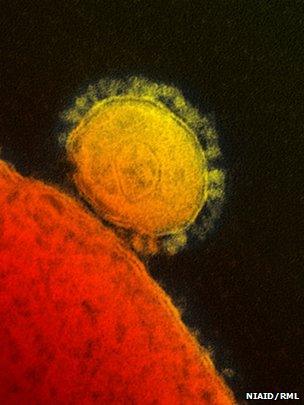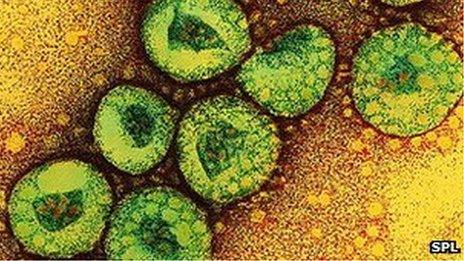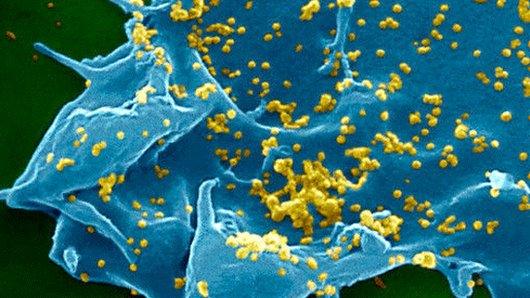New Mers-Coronavirus continues to smoulder
- Published

An electron microscope image of the Mers virus
Prof Jonathan Ball, a virologist at the University of Nottingham, UK, assesses the potential of the Middle East Respiratory Syndrome Coronavirus (Mers-CoV) to spread more rapidly through human populations.
"What's the truth about this new coronavirus - is it like Sars? Should we be worried?"
With each new outbreak, these questions are increasingly posed.
It is almost one year since this virus reared its head and we are only just beginning to piece together the jigsaw - and the truth is some very important pieces are still missing.
The Middle East Respiratory Syndrome Coronavirus (Mers-CoV) emerged in the Arabian peninsula last September and has been smouldering there ever since.
Its sudden appearance and deadly symptoms are frighteningly reminiscent of Sars, which ripped across the world instilling fear in authorities and the public alike.
This, too, was caused by a coronavirus. It was fleeting but it left thousands dead in its wake. And Mers-CoV also seems to specialise in deadly symptoms.
Of the 64 laboratory-confirmed cases reported so far, more than half have died. But these figures might be misleading.
Spread potential
Testing for Mers-CoV has focused on the sick, the dying and the dead, potentially making it appear more deadly than it really is.
We are starting to appreciate that infection can pass without leaving a mark - symptoms can be mild or even absent.
So do the serious infections that are being recorded represent the proverbial tip of the iceberg? Could the virus be circulating benign and unnoticed until the occasional outbreak of serious disease alerts us to its presence?
Prof Paul Kellam, external from the Wellcome Trust Sanger Institute and University College London, an author on a New England Journal of Medicine report, external of a large outbreak, says onward transmission is already happening.
"The data at the moment is suggesting that it's a bit like Sars virus in its mode of transmission," he said.
"When spreading round the world, [Sars] infected just over 8,000 individuals and what we gleaned from that virus was that some individuals didn't transmit on at all and some individuals transmitted onto a number of contacts, and it seems to be the same pattern with this new coronavirus."
Bat connections
It was a small number of "super-spreaders, external" that drove the Sars outbreak.
But despite some onward transmission of Mers-CoV there is not yet evidence of significant human spread and certainly no super-spread. So where are these outbreaks coming from?
An analysis of the viral genomes is starting to shed light on this issue.
The blueprint for life is carried in DNA, but many viruses possess a different, related, genetic material called RNA.
Most viral RNA genomes are small - often around 10,000 individual building blocks or bases - but that of coronavirus is around 30,000 bases, making sequencing with traditional techniques a lengthy process.
But Prof Kellam is one of the scientists applying high throughput next-generation sequencing techniques to quickly determine the genomes of the Mers virus.
And subsequent phylogenetic analysis, external - using computer methods to build virus family trees - is revealing the likely origin, as Prof Kellam explained: "The family tree enables us to estimate when this virus first appeared in humans and that estimate suggests that the virus first came into humans in about the middle of 2011.
"You can build the same sort of trees by comparing the human viruses with all the other coronaviruses you know about in the world, and these show that the most recent common ancestor of this virus is in a species of bat - the pipistrelle bat.
"But that, if you estimate how long ago it was, was about 40 to 150 years ago.
"That's led to the idea that there is an intermediate or a missing animal species where this virus is more common, and that's the source of transmission into humans.
"We don't know where that source is at the moment.
Finding the source
So the evidence suggests that the current outbreaks are repeat spill-overs from this mystery animal reservoir.
Sars virus also had its origins in bats, external. From there, it passed into an intermediate animal - most likely the civet cat in live animal markets - and then leaped into humans.
This jump was not straight forward. The virus had to acquire a number of mutations, possibly in the civet cat or the first humans it infected, to adapt for efficient human transmission.
Whilst the Mers coronavirus is also evolving and adapting, nothing out of the ordinary seems to be happening - at least not yet.
It is understandable that the response to Mers has been measured and restrained, but we should not be complacent.
This is a potentially deadly virus and efficient transmission might only be a matter of time.
To stop this becoming a reality we will need to identify and, if possible, remove the source. This will not be easy - coronaviruses infect a wide range of warm blooded animals.
Controlling Mers in domestic animals is achievable, if a little unpalatable. But if the virus is in animals in the wild - that is a far more challenging prospect.
- Published24 May 2013

- Published12 May 2013

- Published27 April 2013

- Published20 March 2013

- Published2 July 2015
